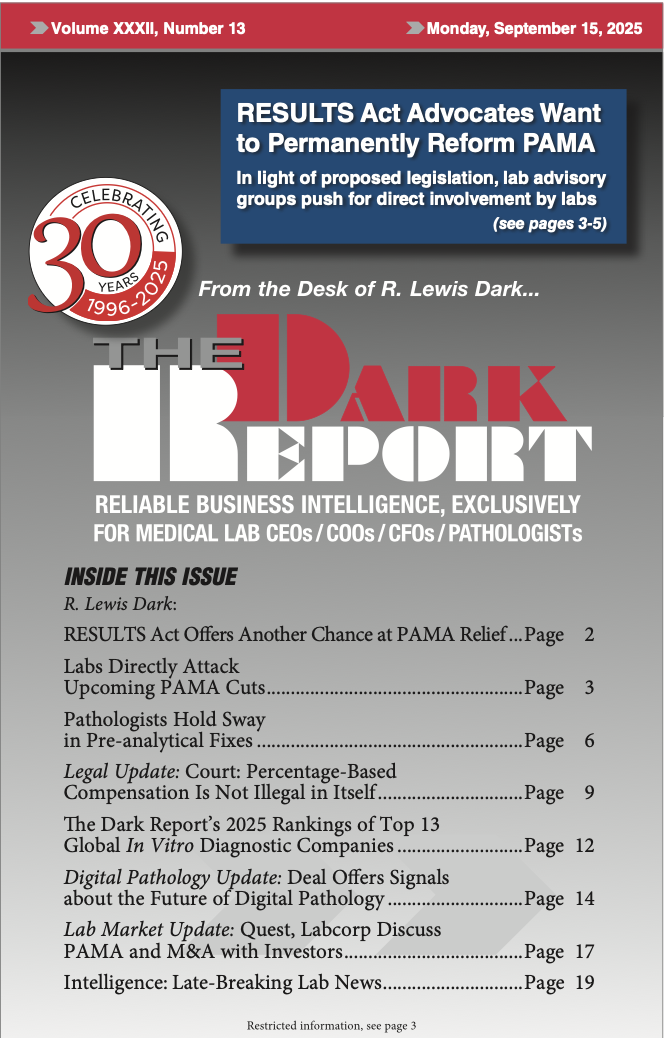Clinical Laboratory
A clinical laboratory is a laboratory where tests are done on clinical specimens in order to get information about the health of a patient as pertaining to the diagnosis, treatment, and prevention of disease.
Clinical laboratories are at the forefront of the personalized medicine trend. However, they are also targets for cost-cutting measures by payers, and increased regulation by CMS and FDA, making the industry a challenging one in which to succeed.
Laboratory medicine is generally divided into two sections, each of which being subdivided into multiple units. These two sections are:
- Anatomic pathology: Units included here are histopathology, cytopathology, and electron microscopy. Other disciplines pertaining to this section include anatomy, physiology, histology, pathology, and pathophysiology.
- Clinical pathology, which includes:
- Clinical Microbiology: This encompasses five different sciences. These include bacteriology, virology, parasitology, immunology, and mycology.
- Clinical Chemistry: Units under this section include instrumental analysis of blood components, enzymology, toxicology and endocrinology.
- Hematology: This section consists of automated and manual analysis of blood cells.
- Genetics is also studied along with a subspecialty known as cytogenetics.
- Reproductive biology: Semen analysis, Sperm bank and assisted reproductive technology.
Credibility of medical laboratories is paramount to the health and safety of the patients relying on the testing services provided by these labs. The international standard in use today for the accreditation of medical laboratories is ISO 15189. Under their respective approaches to laboratory licensure and accreditation, many countries have legal requirements that medical laboratories must be accredited to ISO 15189. This is not true in the United States.
In the United States, there are federal and state laws that address the licensure and accreditation of medical laboratories. Accreditation is done by the Joint Commission, College of American Pathologists, AAB (American Association of Bioanalysts), and other state and federal agencies. CLIA 88, the Clinical Laboratory Improvement Amendments, also dictate testing and personnel.
In addition, many clinical laboratories have adopted quality management programs such as Six Sigma and Lean quality to improve clinical quality, reduce turnaround time, cut costs, and boost productivity. Lean and Six Sigma are both process improvement methodologies. At a very basic level, Lean is about speed and efficiency, while Six Sigma is about precision and accuracy, leading to data-driven decisions. Lean and Six Sigma methods are finding numerous applications in anatomic pathology laboratories and pathology group practices.
Lab Directors Develop Plans for Return of Routine Hospital Care
By Joseph Burns | From the Volume XXXI, No. 12 – September 3, 2024 Issue
CLINICAL LABORATORY DIRECTORS IN MICHIGAN are developing plans to test patients who will return when hospitals reopen for routine care. Included in those plans are strategies to do testing for the novel coronavirus on patients who will return for everyday care and elective procedures, said Bart…
FDA Replaces March 16 Serology COVID-19 Rules
By Joseph Burns | From the Volume XXXI, No. 12 – September 3, 2024 Issue
CEO SUMMARY: In the rush to allow companies and clinical laboratories to develop, validate, and bring to market serological tests for COVID-19, the federal Food and Drug Administration issued rules on March 16 that eased its requirements for these new assays. Because of the la…
Expert Offers Comments on FDA and Revised Serology Test Rules
By Joseph Burns | From the Volume XXXI, No. 12 – September 3, 2024 Issue
CLINICAL LABORATORY DIRECTORS are asking what caused the federal Food and Drug Administration (FDA) to issue a highly questionable policy in March to allow serological tests for SARS-CoV-2 and then change that policy seven weeks later. Under a policy the agency issued March…
California Research Team Analyzes Performance of 12 Serology Tests
By Joseph Burns | From the Volume XXXI, No. 12 – September 3, 2024 Issue
CEO SUMMARY: Researchers with the COVID-19 Testing Project used a multidisciplinary effort to analyze and compare the performance of 12 serological tests. One finding is that, 16 to 20 days or more after a confirmed infection with a molecular test, many of the 12 serological te…
Italy’s SARS-CoV-2 Outbreak Brings Out Best in Clinical Labs
By Joseph Burns | From the Volume XXXI, No. 12 – September 3, 2024 Issue
CEO SUMMARY: Italy was one of the first countries outside of China to experience an explosive outbreak of COVID-19 and its northern provinces were hit hardest by this novel coronavirus. In this exclusive interview with THE DARK REPORT,…
Chicago Lab Launches LDT, Finds 20% Positive
By Joseph Burns | From the Volume XXXI, No. 12 – September 3, 2024 Issue
CEO SUMMARY: After seeing the novel coronavirus spread quickly in China, staff in the Department of Pathology and Laboratory Medicine developed a test to identify the pathogen in patients in Chicago and its suburbs. With the CDC’s assay in hand, it started work on its ow…
In New York, Lab Offers Mobile Virus Sample Collections
By Joseph Burns | From the Volume XXXI, No. 12 – September 3, 2024 Issue
CEO SUMMARY: To allow patients and physicians to order at-home specimen collections of the novel coronavirus, Northwell Labs trained its 12-member mobile phlebotomy service in the procedures needed to collect samples using nasopharyngeal (NP) swabs. Since training occurred in …
Labs in Italy Moved Fast to Develop COVID-19 Tests
By Robert Michel | From the Volume XXXI, No. 12 – September 3, 2024 Issue
Part One in a Series ITALY HAS ONE OF THE WORLD’S SEVEREST OUTBREAKS OF COVID-19 INFECTIONS, based on the number of cases and the mortality rate. In response, clinical laboratories there moved quickly to launch laboratory-developed tests and to increase the volume of COVID-19…
Drive-Up COVID-19 Test Site Launched in 3 Days
By Joseph Burns | From the Volume XXXI, No. 12 – September 3, 2024 Issue
CEO SUMMARY: After seeing the largest cluster of confirmed coronavirus infections in one location, New York State took emergency measures “to attack the hotspot at its source.” The state opened a drive-through specimen-collection site offering free testing without an appoi…
Providers Get Creative as FDA Clears More IVD Firms’ Tests
By Joseph Burns | From the Volume XXXI, No. 12 – September 3, 2024 Issue
CEO SUMMARY: Clinical and molecular test laboratories, hospitals, public health agencies, and other providers are taking unusual measures to expand the number of tests available to identify the spread of the new coronavirus. When a hospital needed funding to buy test kits for …
CURRENT ISSUE

Volume XXXII, No. 13 – September 15, 2025
The Dark Report examines a new bill that would reform PAMA and avoid reimbursement rate cuts scheduled for January 2026. Clinical laboratory leaders are urged to make their voices heard in Congress. Also, an expert describes how labs can fix pre-analytical errors and avoid disaster.
See the full table of contentsHow Much Laboratory Business Intelligence Have You Missed?
Lab leaders rely on THE DARK REPORT for actionable intelligence on important developments in the business of laboratory testing. Maximize the money you make-and the money you keep! Best of all, it is released every three weeks!
Sign up for TDR Insider
Join the Dark Intelligence Group FREE and get TDR Insider FREE!
Never miss a single update on the issues that matter to you and your business.
Topics
- Anatomic Pathology
- Clinical Chemistry
- Clinical Laboratory
- Clinical Laboratory Trends
- Digital Pathology
- Genetic Testing
- In Vitro Diagnostics
- IVD/Lab Informatics
- Lab Intelligence
- Lab Marketplace
- Lab Risk & Compliance
- Laboratory Automation
- Laboratory Billing
- Laboratory Compliance
- Laboratory Equipment
- Laboratory Information Systems
- Laboratory Management
- Lean Six Sigma
- Managed Care Contracts
- Molecular Diagnostics
- Pathology Trends
- People
- Uncategorized

